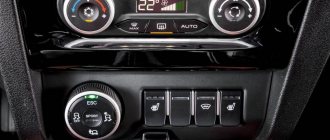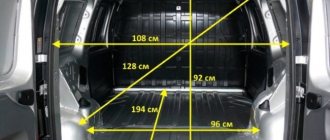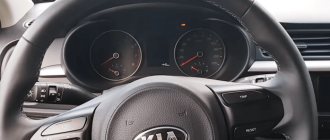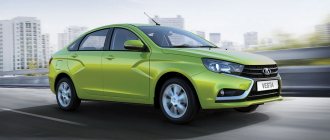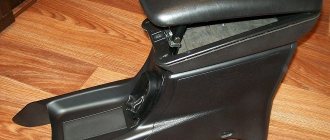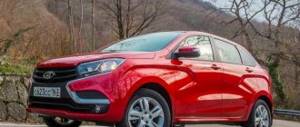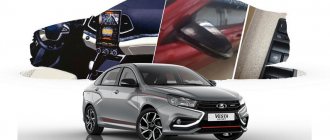Lada Vesta SV: what does SV mean
Lada with the addition of 2 letters SV means - we are dealing with a car designed for active recreation and fast driving . Many car enthusiasts believe that such an addition to the name is a marketing ploy. The goal is to increase sales. In terms of class, the car is at the junction of 3 specifications : crossover, station wagon, coupe. The ground clearance was taken from the crossover, the trunk from the station wagon, the design was borrowed from the coupe.
Higher and higher
The car I had a chance to drive was equipped with a 122-horsepower 1.8-liter engine. AvtoVAZ representatives say that “it uses the most modern engine controller firmware, which has improved its performance and increased dynamics.” I am quoting this from the official press release. In fact, the character of the power unit here is quite specific. The traction from the bottom definitely leaves much to be desired. Where did they take all these horses? But where to go, up! Far up. The engine noticeably comes to life from about 4500 rpm, and literally shoots the car forward. You need to remember this when overtaking and don’t be afraid to rev the engine harder. But you should switch “down” more carefully. The fact is that already at 6000 rpm the cut-off occurs and the electronics abruptly shut off the fuel supply. When accelerating hard, it feels like the car is hitting a wall. The driver is literally hanging from his seat belts. Couldn't the cut-off have been organized somehow more delicately? And the operating range of the engine, when the car is as dynamic as possible, turns out to be too narrow.
In total, three modifications of the Lada Vesta Cross will go on sale. The most affordable of them will be equipped with a 1.6-liter gasoline engine producing 106 hp. This engine is only compatible with a 5-speed manual transmission. For more expensive versions, a 122-horsepower 1.8-liter unit is provided. When purchasing a car with such an engine, the buyer is already free to choose between a 5-speed manual transmission and VAZ’s proprietary AMT robotic transmission. All available modifications will be exclusively front-wheel drive. The fact is that the platform on which all models of the Vesta family are based does not even theoretically imply the use of all-wheel drive.
Personally, I would really like to have a wider “torque shelf”, and even move it lower in the rev range. Still, you must admit that for a car that has to go off-road, low-end torque is important. But here it’s somehow not enough. I'm sure the automaker itself is aware of this problem. How else can one explain the fact that on our modification of the Vesta Cross with a 1.8-liter engine and a 5-speed manual transmission, he installs a shorter main gearbox: 4.2 versus the standard 3.9. This does not completely solve this problem, but it allows you to make the car a little more dynamic when starting from a standstill. I wouldn't call this Vesta Cross sluggish. Acceleration to “hundreds” takes 10.2 seconds, and this is not bad at all. The maximum speed, according to the manufacturer, is 180 km/h. Downhill and with a tailwind, as they say, we managed to accelerate the car to 193 km/h. This, please note, is GPS data, not speedometer data. But such high speeds of Vesta Cross are clearly contraindicated. Already at 140-150 km/h the front part of the car is noticeably unloaded, and it becomes less stable in a straight line. In addition, they are also extremely sensitive to side gusts of wind and long asphalt waves. Miracles, alas, do not happen - twenty centimeters of air under the bottom at high speeds has never benefited anyone.
The car we drove was equipped with a 5-speed manual transmission. There are no cars with robotic transmissions in the demonstration fleet yet. It's a pity! The old unit, which was often criticized for being too “thoughtful” when changing gears, gave way to the updated version of AMT 2.0, as the Togliatti residents themselves call it. The developers claim that in the reconfigured box, switching time has decreased by 40%. There is also a “winter mode” that allows you to move away in second gear on slippery surfaces. The function of “creeping movement” in dense traffic has been introduced. The car will now move forward as soon as the driver takes their foot off the brake.
I really liked the steering. It is quite sharp - only 2.8 turns of the steering wheel from lock to lock, and is “transparent” in terms of information content. I won’t say a bad word about the gear shift mechanism - it is clear and with excellent selectivity. You can click the manual transmission gears not even with your whole hand, but only with your fingers. It is convenient to do this by placing your right hand on the standard armrest. I also praise the Togliatti residents for the quality of the interior decoration. After all our racing on dirt roads and broken asphalt, not a single “cricket” started in the car. Nothing came loose or rattled. However, in fairness, I note that some of my colleagues complained about the creaking of the front anti-roll bar, which sometimes occurred when driving over bumps, but I didn’t notice anything like that on my car.
Comparison of Lada Vesta and Lada Vesta Cross engines
The engines of both models are almost the same. When buying Vesta SV, you will have to choose 1 of 4 options . In the case of Cross - 1 of 3 , they simply decided not to produce a crossover brand with a 1.6 engine; they thought that a robotic gearbox was quite enough.
When choosing a car, you need to inspect the volume of the combustion chamber, torque, and power. They have different acceleration, maximum speed and fuel consumption . In comparison, the engine is 106 hp. will turn out to be underpowered . Accordingly, it is inferior in acceleration speed. The difference in combustion chamber volume is 178 cc.
Lada Vesta SV and Cross - what are the differences
Outwardly, these two representatives are very similar, but there are still some differences. The dimensions of the models are almost the same. The cross is somewhat larger, it has large front and rear overhangs. The wheelbase of both versions is identical, but the sports car has a larger track width. Another attractive feature of the sports model is that it has 2.5 cm more ground clearance. This was achieved thanks to retuning the suspension and extended springs.
Lada Vesta and Lada Vesta cross comparison
| Parameter | Lada Vesta SW | Lada Vesta SW Cross |
| Original body kit | X | |
| Body color "Mars" | X | |
| Orange interior trim | X | |
| Exhaust pipe nozzle | X | |
| 1.6 l 16 cl. (106 hp), 5AMT | X | |
| Ground clearance | 178 mm | 203 mm |
| Modified suspension | X | |
| Wheels R17 | X |
How do the configurations differ?
Lada Vesta SV Cross
If we consider the 1.6 liter model. There is no option to select a gearbox. One configuration is mechanical . Choose a media installation - regular standard or multimedia.
1.8 liter model has a wide selection. Choose between a manual transmission and a robot. These cars are offered in the Prestige . If it is present, the appearance of the interior will change. The rear seats will have armrests. LED lighting will appear in the cabin . The rear window will have a darker tint. The price of the car includes an additional charge for color. For a fashionable one you will have to pay up to 12,000 . The “Orange Mars” design costs about this much.
Lada Vesta SV
The windshield is over the entire surface and the locks are protected from freezing. The car is equipped with a hood deflector . Wear-resistant carpets protect the interior and trunk.
Model design
The first glance at a book is always at its cover; you don’t judge the book by it, but you can judge the owner of the car with almost 100% confidence by its design. In their new models, VAZ maintains style. Still the same bias towards sports, which is not surprising, because SW stands for “SportWagon”, all the same stylish X-shaped patterns. But AvtoVAZ nevertheless made a difference between the Lada Vesta SW and the Lada Vesta SW Cross. In terms of body design, we are more impressed by the Vesta Cross, firstly, the color of the Lada Vesta SV Cross is “Mars”, in other words, metallic orange. But more significant is the black plastic body kit; this part protects the most vulnerable spot of the car from scratches, and subsequently, from rotting. A decorative exhaust tip makes the car more sporty and aggressive, while the regular Lada Vesta SW does not look so menacing and daring. Looking at the Vesta SW Cross, you can immediately see that it is for off-road use, which is not too different from what we call roads; its driver is a lover of active recreation in almost extreme places with his family or a group of friends. While the driver of the Vesta SW is also no stranger, but instead of off-road, he relies on any road, but the road, and his passion is not conquering hard-to-reach areas, but active recreation in the country and, of course, barbecues.
Price for CASCO both models
The price for CASCO insurance will look different depending on the region
The cost of a crossover for a model will be calculated individually. The price largely depends on the equipment of the car. driving experience will affect the CASCO amount .
You can reduce the price if you take advantage of insurance company discounts and promotions.
On average, the price may rise after evaluation to 579900 . You can find out the exact price if you contact the office of the insurance company and leave a request there.
Comparison of technical parameters
Everything here is almost completely identical. For the SV version, four engine plus gearbox combinations are available:
- 1.6 liters for 106 horses with mechanics;
- 1.6 liters per 106 horses with AMT;
- 1.8 l (122 horsepower) coupled with manual transmission;
- 1.8 l per 122 l. With. with robotic transmission.
All gearboxes are five-speed, engines are 16 valves. The only difference here is that the LADA Vesta SW Cross does not have the option with a 1.6-liter engine along with a robotic gearbox.
Lada Vesta SV
On average, insurance will cost 7% of the total cost of the car at the time of insurance. Further, the cost may increase or decrease depending on the selected insurance company.
The price is greatly influenced by the equipment of the car. Let's say the cost of the car is 650,000 . Then the cost of insurance for a middle-aged person with a normal driving record will cost about 60,000 . For a legal entity, the cost will be increased by 5 thousand rubles . You can save money when choosing a franchise. But insurance payments in this case will only be paid after a serious incident .
Many companies offer CASCO insurance in installments.
Dimensions
If we talk about the sizes of the models, there are also no special differences. The main difference is the slightly larger overhangs of the SV Cross. Moreover, the wheelbase of both cars is completely identical. The cross version is slightly larger in track width (by 1.4 cm). It also features increased ground clearance - it has increased by 25 millimeters compared to the regular version. This was achieved by lengthening the springs, as well as reconfiguring the suspension. Thus, the Cross version really has increased cross-country ability.
It will also be interesting to read: Volkswagen Touareg: technical specifications
The rims are also slightly different. For the SV modification, 15- and 16-inch options are available. The Cross model is equipped exclusively with seventeen-inch wheels. As a result, the tires on these cars are also different. True, the passable station wagon is made on low-profile tires. Car owners still cannot understand why, but this is a clear drawback of the Cross model.
Vesta or Vesta Cross: what to choose
The choice between a station wagon and a crossover is not easy. It completely depends on the purpose for which the car is purchased. For example, a station wagon has a more spacious trunk . This model is designed for travel. Although the crossover is designed for not entirely urban conditions. Both cars meet the latest safety requirements .
Price can seriously influence the choice. Based on it, the equipment is selected.
Engine performance and fuel consumption
The difference between Cross and just Vesta SW in engines and gearboxes lies only in the difference in their combinations. So, a regular station wagon has 16 valve engines of 1.8 and 1.6 liters with 122 and 106 horsepower, respectively. As well as manual and “robot” gearboxes on each of these engines. Vesta SW Cross does not have a “robot” on the 1.6 liter engine. The fuel consumption of a 1.6 liter engine per 100 km is from 7 to 7.3 liters, but the 1.8 liter engine is from 7.6 to 7.8. In general, reviews about the greater technical perfection and convenience of the 1.6 liter engine can be called close to the truth, so you should think twice before than to pay more money for additional volume.
Differences in price
Perhaps this interests car owners most of all. The price of the regular version is 639-805 thousand, the all-terrain station wagon will cost you about 756-848 thousand. The main dilemma arises if you have about 760 thousand rubles in your hands. This is the amount the Lux Multimedia SV version will cost, as well as the Luxury SV Cross package.
It will also be interesting to read: Armrest from Lada Vesta SV Cross - review and capabilities
Advantages of a regular station wagon for 760 thousand:
- a more powerful 1.8-liter power unit;
- a good multimedia system with a built-in navigator and a seven-inch monitor;
- presence of a rear view camera.
Advantages of the Cross version for 760 thousand:
- presence of original body kit;
- interesting body shade “Mars”;
- orange interior trim;
- exhaust tip;
- higher ground clearance;
- slightly different suspension;
- alloy wheels R17.
It is based on these parameters that you need to make a choice in favor of one car or another.
What to choose
To be extremely objective, for the same money the regular Lada Vesta SV model is a little better. First of all, this concerns a more powerful 1.8-liter engine, ease of reverse maneuvers thanks to the camera, as well as the presence of a multimedia system, which will make the trip much more enjoyable.
At the same time, it is necessary to take into account the peculiarities of vehicle operation. Indeed, thanks to the increased ground clearance, a slightly different suspension and seventeen-inch alloy wheels, the Cross model feels more comfortable off-road. In any case, before purchasing, it is advisable to read reviews from real owners, as well as drive both vehicles.
And then in the video all the jambs of these cars:
